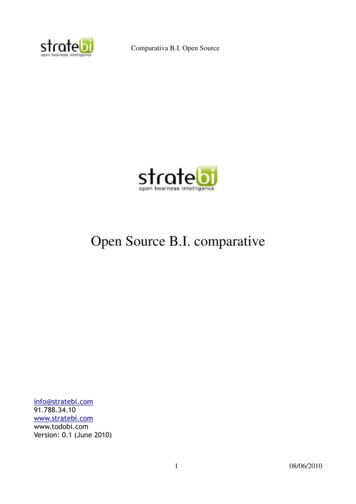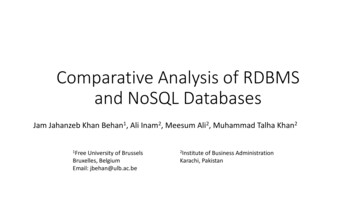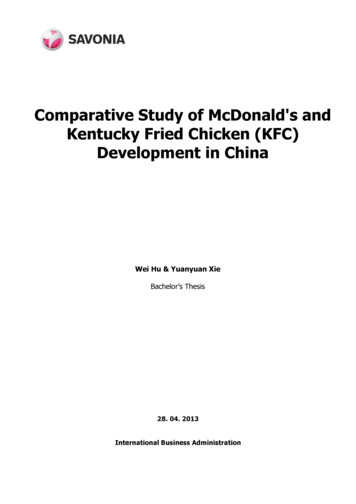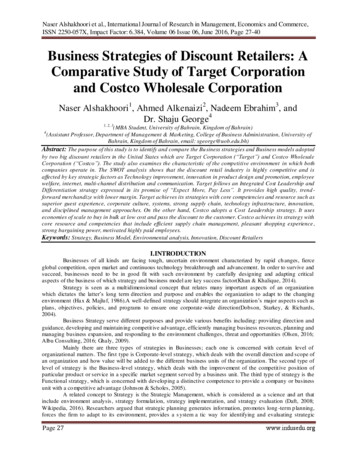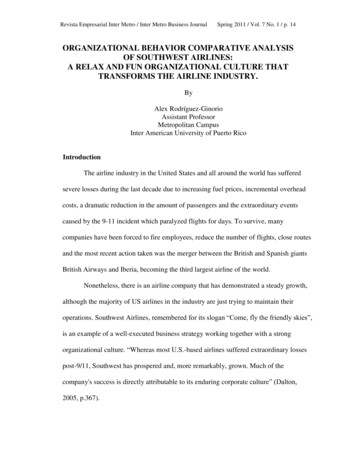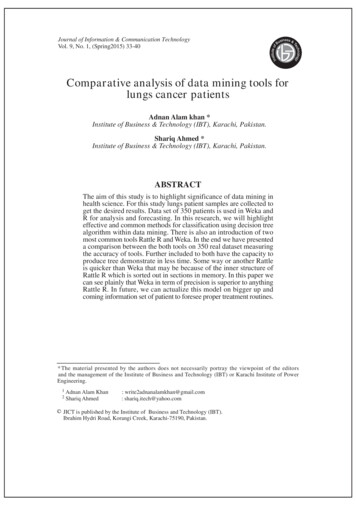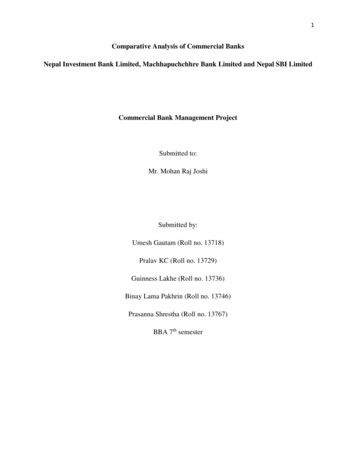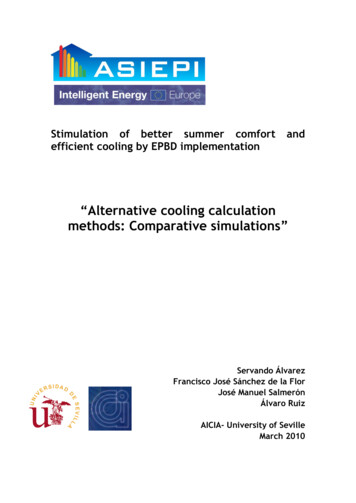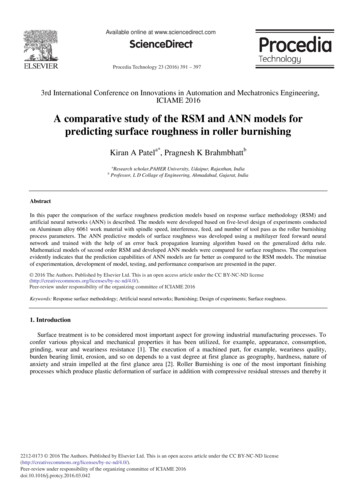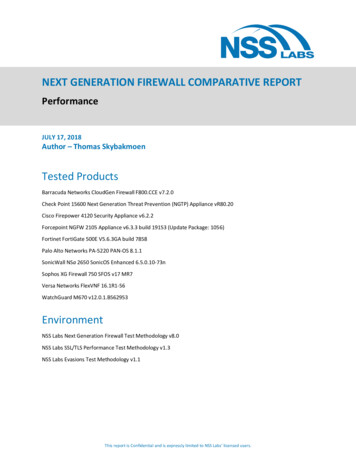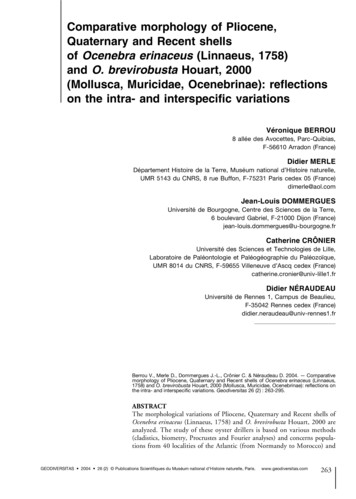
Transcription
Comparative morphology of Pliocene,Quaternary and Recent shellsof Ocenebra erinaceus (Linnaeus, 1758)and O. brevirobusta Houart, 2000(Mollusca, Muricidae, Ocenebrinae): reflectionson the intra- and interspecific variationsVéronique BERROU8 allée des Avocettes, Parc-Quibias,F-56610 Arradon (France)Didier MERLEDépartement Histoire de la Terre, Muséum national d’Histoire naturelle,UMR 5143 du CNRS, 8 rue Buffon, F-75231 Paris cedex 05 (France)dimerle@aol.comJean-Louis DOMMERGUESUniversité de Bourgogne, Centre des Sciences de la Terre,6 boulevard Gabriel, F-21000 Dijon ine CRÔNIERUniversité des Sciences et Technologies de Lille,Laboratoire de Paléontologie et Paléogéographie du Paléozoïque,UMR 8014 du CNRS, F-59655 Villeneuve d’Ascq cedex (France)catherine.cronier@univ-lille1.frDidier NÉRAUDEAUUniversité de Rennes 1, Campus de Beaulieu,F-35042 Rennes cedex (France)didier.neraudeau@univ-rennes1.frBerrou V., Merle D., Dommergues J.-L., Crônier C. & Néraudeau D. 2004. — Comparativemorphology of Pliocene, Quaternary and Recent shells of Ocenebra erinaceus (Linnaeus,1758) and O. brevirobusta Houart, 2000 (Mollusca, Muricidae, Ocenebrinae): reflections onthe intra- and interspecific variations. Geodiversitas 26 (2) : 263-295.ABSTRACTThe morphological variations of Pliocene, Quaternary and Recent shells ofOcenebra erinaceus (Linnaeus, 1758) and O. brevirobusta Houart, 2000 areanalyzed. The study of these oyster drillers is based on various methods(cladistics, biometry, Procrustes and Fourier analyses) and concerns populations from 40 localities of the Atlantic (from Normandy to Morocco) andGEODIVERSITAS 2004 26 (2) Publications Scientifiques du Muséum national d’Histoire naturelle, Paris.www.geodiversitas.com263
Berrou V. et al.264KEY nean shorelines. The results indicate a morphological distributionof North/South orientation, the more derived southern forms being closelyrelated. In spite of a strong variability, a beginning of differentiation, probably dating from the Plio-Pleistocene, is observed between three groups:1) Northern Atlantic Ocean (O. erinaceus); 2) Mediterranean Sea (O. erinaceus); and 3) Moroccan Atlantic (O. brevirobusta). O. brevirobusta is temporarily regarded as a geographic subspecies of O. erinaceus, because of itsuninterrupted marginal area, and its P2 cord more atrophied than in theItalian late Pliocene O. erinaceus. Within these groups, the multivariate analysis of variance distinguishes local biogeographic entities. In addition, twounexpected results deserve to be stressed: 1) the population from Étang deThau, systematically associated to those of the Northern Atlantic Ocean, islocated in a zone of oyster importation from the Oléron island; and 2) thepopulation from Algarve (Portugal), closer to those of the Mediterranean Sea,lives in an Atlantic area undergoing the influence of Mediterranean waters.Comparisons between O. erinaceus and Ocinebrellus inornatus (Récluz, 1851),an Asian species introduced on the French Atlantic coast, show more similarities with the Northern Atlantic O. erinaceus, than with Mediterranean orMoroccan Atlantic O. erinaceus.MOTS ÉSUMÉComparaison morphologique des coquilles pliocènes, quaternaires et actuellesd’ Ocenebra erinaceus (Linnaeus, 1758) et d’ O. brevirobusta Houart, 2000(Mollusca, Muricidae, Ocenebrinae) : réflexion sur les variations intra- et interspécifiques.La variation morphologique de coquilles pliocènes, quaternaires et actuellesd’Ocenebra erinaceus (Linnaeus, 1758) et d’O. brevirobusta Houart, 2000 estanalysée. L’étude de ces perceurs d’huîtres, fondée sur différentes méthodes(analyse cladistique, biométrie, morphométrie géométrique et transformée deFourier), porte sur des populations de 40 localités des côtes atlantiques (de laNormandie au Maroc) et méditerranéennes. Les résultats indiquent unerépartition morphologique d’orientation Nord/Sud, les formes méridionales,plus dérivées, étant étroitement apparentées. Malgré une forte variabilité,un début de différenciation, datant probablement du Plio-Pléistocène,s’observe entre trois groupes de populations : 1) Atlantique septentrional(O. erinaceus) ; 2) Méditerranée (O. erinaceus) ; et 3) Maroc atlantique(O. brevirobusta). O. brevirobusta est provisoirement considérée comme unesous-espèce géographique d’O. erinaceus, en raison d’une aire marginale nondisjointe et d’une atrophie du cordon P2 plus marquée chez les O. erinaceusdu Pliocène supérieur italien. Au sein des trois groupes, l’analyse multivariéede variance distingue des entités biogéographiques locales. Deux résultatsinattendus méritent d’être soulignés : 1) la population de l’Étang de Thau,systématiquement associée par les analyses à celles de l’Atlantique septentrional, est située dans une zone d’échanges d’huîtres avec l’île d’Oléron ; et 2) lapopulation de l’Algarve (Portugal), morphologiquement proche de celles deMéditerranée, est située dans une région de l’Atlantique subissant l’influencedes eaux méditerranéennes. Les comparaisons entre O. erinaceus etOcinebrellus inornatus (Récluz, 1851), espèce introduite par l’homme enAtlantique, révèlent de plus grandes similitudes avec les O. erinaceus del’Atlantique septentrional qu’avec celles de Méditerranée ou du Maroc.GEODIVERSITAS 2004 26 (2)
Shell variations in European Ocenebra (Mollusca, Muricidae)INTRODUCTIONDuring the last decades, numerous allochthonousspecies of molluscs have been introduced on theFrench Atlantic coast by human way (Gruet et al.1976; Sauriau 1991; Montaudouin & Sauriau2000). One of the last introductions is that of anocenebrine, Ocinebrellus inornatus (Récluz,1851). It is dated from 1997 and reported in theMarennes-Oléron basin (Charente-Maritime,France). The species is often assigned toOcinebrellus Jousseaume, 1880 (type species byoriginal designation: Murex eurypteron Reeve,1845 [a junior synonym of M. aduncus Sowerby,1834]), but has been recently transferred (Houart& Sirenko 2003) in the genus Ocenebra Gray,1847 (type species: O. erinaceus Linnaeus, 1758by monotypy). Ocinebrellus inornatus is an oysterdriller. Although it does extend into warm temperate waters, the species is properly a low-boreal,cool water temperate form. It is native from eastern, western Japan and mainland Asia, from 33 to 51 north latitude. O. inornatus has alreadybeen introduced by human way on the Pacificcoasts of Oregon, Washington and BritishColumbia (Radwin & Attilio 1976; Carlton1992; Noda et al. 1993). On the French shoreline, O. inornatus begins dangerously to damagethe oyster farming, and consequently this invasion may have economical repercussions. Themolecular analysis of the French O. inornatusdemonstrates that it has been introduced froma stock having closer relationships with theAmerican population than the Asian (GarciaMeunier et al. 2001; Martel et al. 2003).Moreover, its life environment corresponds tothat of O. erinaceus (Pigeot et al. 2000; KosterSperling 2002) and a dramatic decrease of theautochthonous oyster drill is reported whenO. inornatus shows a high density (Pigeot et al.2000). Therefore, some populations of O. erinaceus might be locally extirpated and a study ofits morphological variation also answers to thenecessity to better understand the evolutionarypotential of the species.On the European and North-African coasts,three Ocenebra species have been recorded:GEODIVERSITAS 2004 26 (2)O. erinaceus, O. brevirobusta Houart, 2000(Houart 2000a) and O. chavesi Houart, 1996(Houart 1996). Fossils of O. erinaceus have beenreported from the middle Miocene of Poland(Baluk 1995), but the identification by Baluk(1995) is probably wrong, the figured specimensbeing more similar to members of the genus JatonPush, 1837 (type species by original designation:Murex decussatus Gmelin, 1791), particularlyJ. dufreynoi (Grateloup, 1847) or J. sowerbyi(Michelotti, 1842). However, the occurrence ofO. erinaceus is well attested in the Pliocene ofItaly (Malatesta 1974), Spain (Muniz Solis &Guerra-Merchan 1994; Martinell 1979;Martinell & Marquina 1981) and in thePleistocene of the Northern domain (Glibert1963). The geographic range of Recent populations of O. erinaceus (Fig. 1A) extends fromSouthern England and Ireland to theMediterranean Sea and the Gibraltar Strait. Thespecies is also reported from Madeira (Houart2001a), Canary Islands (Garcia-Talavera 1974)and from Azores, where it has been recentlyintroduced (Houart & Abreu 1994; Houart2001a). The fossils of O. brevirobusta are reported from the lower Pleistocene (MoghrebianMessaoudian) of Morocco by Brébion (1978,1979a, b) under the name Murex torosusLamarck, 1816, which probably corresponds to ajunior synonym of the Pliocene speciesHeteropurpura polymorpha (Brocchi, 1814) (seeHouart 2000a). The geographic range of Recentpopulations of O. brevirobusta (Fig. 1A) isrestricted to the Moroccan Atlantic coast (ElJadida, Rabat, Temara, Essaouira [ Mogador],Agadir and Asilah) and northward, it does notpass Tanger. Following Houart (2000a, 2001a),O. brevirobusta and O. erinaceus are sympatric atAsilah. O. chavesi is an endemic species from theAzores and is only known from San MiguelIsland. No fossil of Ocenebra are reported fromMiocene and Quaternary terraces of Santa MariaIsland (Zbyszewski & da Veiga Ferreira 1961,1962) belonging to this archipelago.As seen above, the geographic range of O. erinaceus and O. brevirobusta is continuous(Fig. 1A). The absence of a clear geographic265
Berrou V. et al.AOcenebra erinaceusOcenebra brevirobustaOcenebra chavesiBO. erinaceus (Recent)O. erinaceus (fossil)O. brevirobusta (Recent)O. brevirobusta (fossil)Ocinebrellus inornatus (Recent)FIG. 1. — A, geographic range of the genus Ocenebra Gray, 1847 in Europe after Houart (2001a) modified; B, geographic location ofthe studied samples; photos of Ocenebra, courtesy of R. Houart.266GEODIVERSITAS 2004 26 (2)
Shell variations in European Ocenebra (Mollusca, Muricidae)discontinuity questions the biological reality ofboth species. In addition, the legendary intraspecific variation of O. erinaceus (no less than 49superfluous names! [Houart 2001a]) and the taxonomic individualisation of O. brevirobusta fromO. erinaceus, which is not based on a modernanalysis of the shell variation, also justify thisinterrogation. These observations constitute themain source of our thought. Combining severalmethods of comparative morphology, the goal ofthis work will be to analyse the shell variation ofthese Ocenebra in order to know if the populations reflect a process of morphological differentiation. O. erinaceus and O. brevirobusta will beclosely analyzed, but Ocinebrellus inornatus willbe also included in order to compare the specieswith European Ocenebra. We used the followingmethods:– cladistic analysis to search for the relationshipsbetween the populations;– traditional biometry to describe transformations of the shell shape and the sculptural characters during the ontogeny;– Procrustes analysis to delineate variations ofsculptural characters;– Fourier analysis to study variations of outlines.ABBREVIATIONSText-conventions used to describe the spiral sculpture ofthe teleoconch (after Merle 1999, 2001)abisabapical secondary cord of the suturalramp;ABPabapical primary cord of the siphonalcanal;absabapical secondary cord of the siphonalcanal;adisadapical secondary cord of the suturalramp;ADPadapical primary cord of the siphonalcanal;adsadapical secondary cord of the siphonalcanal;Ddenticles of the outer lip;D1 to D6 abapical denticles;IDinfrasutural denticle;IPinfrasutural primary cord;MPmedian primary cords of the siphonalcanal;msmedian secondary cord of the siphonalcanal;Pprimary cords (first appearance sequence);P1shoulder cord;GEODIVERSITAS 2004 26 (2)P2 to P6ss1 to s6RepositoryMNHNprimary cords of the convex part of thewhorl;secondary cords (second appearancesequence);secondary cords of the convex part of thewhorl.Muséum national d’Histoire naturelle,Paris, domaine de collection Sciences de laTerre.Other abbreviations concerning the localities: seeAppendix 1.MATERIALNew material (V. B.) of Ocenebra erinaceus hasbeen sampled on the French coast (AtlanticOcean and Mediterranean Sea) in order to complete the available collections and to closely coverthe geographic range of the species (Fig. 1B). Thetidal zones have been closely prospected duringthe low tides for a better knowledge of its repartition. For each sample, the environmental characteristics (orientation of the sample stations,substrates, associated fauna and flora) have beenalso registered the soonest possible. The detailedlist of the studied populations including fossiland Recent O. erinaceus and O. brevirobusta ispresented in the Appendix 1. Among all populations, a random sampling of the 32, 10 or fiveselected specimens for the different analyses(cladistics, Fourier and Procrustes) has beenprocessed by the computer program MicrosoftExcel.METHODSIDENTIFICATION OF SCULPTURAL CHARACTERSAND STRUCTURAL HOMOLOGIESThe way to consider the muricid sculpture has adirect influence on the perception of their diversity and therefore on the results of morphologicalanalyses (Merle 1999). This observation is particularly true for cladistic studies, in which structural homologies should be defined in a previousstep of the analysis. For the axial sculpture, Miller267
Berrou V. et al.(1999) demonstrated that characters (constructional characters) are usually considered as similar, but may be built by different constructionalpathways and then should not be regarded ashomologous. For the spiral sculpture, the mostaccurate method to propose a hypothesis ofhomology consists in using a criterion of topological correspondence (Hylleberg & Nateewathana1992), in associating another criterion, the ontogenetic correspondence (homologous sequencesof appearance of the cords). This last criterion isfundamental because during the growth, the relative relief of cords may dramatically change andconsequently represents a pitfall when the topological position of these cords is only identifiedby the adult morphology (Merle 1999, 2001).The propositions of structural homologies arecoded by text-conventions used at familial level(Merle 1999, 2001, 2002; Houart 2000b,2001b, 2002a, b; Houart & Dharma 2001;Merle et al. 2001; Merle & Pacaud 2002a, b) andare given in the Abbreviations above.CLADISTIC ANALYSISThe objective of the cladistic analysis is focusedon the relationships between the populations ofOcenebra erinaceus, O. brevirobusta and Ocinebrellus inornatus. It will allow obtaining a phylogenetic hypothesis. The results will be confrontedwith the further analyses.The ocenebrine phylogeny is poorly studied(Vermeij & Vokes 1997) and only the works byKool (1993a, b), Merle (1999), Marko &Vermeij (1999), Oliverio & Mariottini (2001)and Oliverio et al. (2002) provide scattered data.Using anatomical characters, Kool (1993a, b)demonstrated that several genera, as NucellaRöding, 1798 (type species by subsequent designation [Stewart 1927]: Buccinum filosumGmelin, 1791, junior synonym of Nucella theobroma Röding, 1798 and senior objective synonym of Buccinum lapillus, Linnaeus, 1758; for acomplete discussion see Kool & Boss [1992]) andAcanthina Fischer von Waldheim, 1807 (typespecies: Buccinum monodon Pallas, 1774 by original designation), which were previously attributed to the subfamily Rapaninae Gray, 1853, are268in fact more closely related to Ocenebra(Ocenebrinae). This result is also reached byMerle (1999) using shell characters and byMarko & Vermeij (1999) using molecular data.At subfamilial level, Oliverio & Mariottini(2001), using molecular data (12S RNAsequence) suggested that Nucella may be regardedas a basal taxon, which is more closely related toPhyllonotus Swainson, 1833 (type species by subsequent designation [Swainson 1833]: Mureximperialis Swainson, 1833 non M. imperialisFisher von Waldheim, 1807 [new name: M. margaritensis Abott, 1958]; subfamily MuricinaeRafinesque, 1815) than Stramonita Schumacher,1817 (type species by original designation:Buccinum haemastoma Linnaeus, 1767; subfamilyRapaninae). Conversely, in a further study basedon the secondary structure ITS2, Oliverio et al.(2002) suggested, with reserve, that Nucella maybe regarded as sister group of the Rapaninae. Forthe present study, all the results are useful toselect two functional outgroups: N. lapillus andOcinebrina edwardsi (Payraudeau, 1826). Thesetaxa correspond to European ocenebrine speciessharing homologous structures and bearing cleardifferences with Ocenebra.One or several specimens of more than 30 populations of Ocenebra have been included in theanalysis. In the matrix, each specimen has beenregarded as a taxon. We have also carefullychecked that all specimens correspond to a samestep of growth (see Results: Growth of the outerlip). The matrix has been processed by the computer programs Winclada99 (Nixon 1999) andHennig86 (Farris 1988).BIOMETRIC ANALYSISThis approach consists in using linear measurements (raw values and indices), assessing to theproportions of the organism (shell), and describing the morphogenesis of a structure. For twostudied populations (O. erinaceus from Malagaand O. brevirobusta from Atlantic coast ofMorocco) containing numerous young specimens, the analysis of ontogenetic series willattempt to simulate the growth of a “consensualindividual”, for which the size will be assimilatedGEODIVERSITAS 2004 26 (2)
Shell variations in European Ocenebra (Mollusca, Muricidae)to the age. In many cases, the size and the age arelargely correlated and for the paleontologists, thesize represents a convenient estimation, but notwithout pitfalls (Dommergues et al. 1986;Allmon 1994). The retained measurements are:H (total height), HA (height of the aperture),WA (width of the aperture), HLW (height of thelast whorl), HS (height of the siphonal canal),WS (width of the shoulder), HP1 (height of theP1 cord spine), TP1 (thickness of P1), and BCS(distance between the base and the old siphonalcanal) (Fig. 2). The bivariated plots provideinformations on the type of growth. They arebased on the law of allometric growth having asequation Ly ß(Lx)α or log Ly α log Lx log ß;Lx and Ly corresponding to the sizes of organs,a and b corresponding to the constants.PROCRUSTES AND FOURIER ANALYSESThe muricid shells bear a complex morphologycharacterized by varices and cords varying intheir size, form and number. For this reason,the methods of traditional biometry are insufficient to fully delineate intra- and interpopulation differences among the studied Ocenebra.Therefore, the Procrustes and the Fourieranalyses are used in order to complete the biometrical study. Considering the technicalnecessities of these methods and time-consuming mathematical treatments, the followingprotocol is adopted:– the number of localities is prioritized to thenumber of specimens among each population inorder to cover the widest geographic range.Consequently, a limit of five to 10 specimens hasbeen retained for the Procrustes and the Fourieranalyses;– in order to minimize effects of ontogenetic variations, only adults specimens sharing a relativeequivalent size and a same degree of constructionof the outer lip (see Results: Growth of the outerlip) have been considered in the analyses;– the landmarks in ventral view (Procrustesmethods) and the outlines in ventral and dorsalviews (Fourier transform) have been digitalizedusing drawings made with a camera lucida, andthen have been scanned.GEODIVERSITAS 2004 26 (2)WSHTP1HLWHP1HSBCSF IG . 2. — Linear measures used for the biometric study ofOcenebra Gray, 1847. Abbreviations
Quaternary and Recent shells of Ocenebra erinaceus (Linnaeus, 1758) . Murex eurypteronReeve, 1845 [a junior synonym of M. aduncusSowerby, 1834]), but has been recently transferred (Houart . s1 to s6 secondary cords of the convex part of the who
